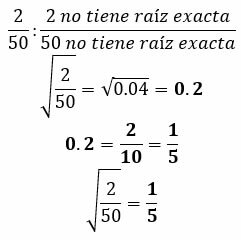Example of Square Root of Fractions
Math / / July 04, 2021
Fractions are numerical values that are written with a numerator and a denominator, and represent quantities that do not complete the unit (the integer: 1), or that exceed it, but have a surplus. When dealing with numbers, fractions participate in basic mathematical operations: addition, subtraction, multiplication and division. And they can also be calculated the square root.
To solve the square root of a fraction, you must know the following in advance:
- The square root is the inverse operation to squaring.
- A high number squared is the one who has multiplied by itself.
- A fraction, the result of a squaring, is a multiplication of equal numerators over a multiplication of equal denominators.
- The square root of a fraction is the square root of the numerator divided by the square root of the denominator.
How do you get the square root of a fraction?
When you want to calculate the square root of a fraction, you will have two cases:
- Exact square root of a fraction
- Inaccurate square root of a fraction
Exact square root of a fraction
The square root of a fraction is going to be exact if both the numerator and denominator are results of squaring.
For example:

Inaccurate square root of a fraction
The square root of a fraction will be inaccurate if either the numerator, or the denominator, or both, are not the result of squaring. The root of each would have decimal numbers. Therefore, the procedure that will have to be followed is:
- Calculate the division: numerator by denominator. It will have a decimal number.
- The square root of the decimal number is obtained.
- The result is represented as a fraction.

Examples of Square Root of Fractions

Follow with:
- Fractions
- Sum of fractions
- Subtraction of fractions
- Multiplication of fractions
- Division of fractions



